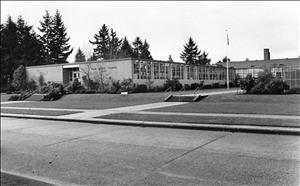This People's History of View Ridge Elementary School is taken from Building for Learning: Seattle Public School Histories, 1862-2000 by Nile Thompson and Carolyn J. Marr. That book, published in 2002 by Seattle Public Schools, compiled profiles of all the public school buildings that had been used by the school district since its formation around 1862. The profiles from the book are being made available as People's Histories on HistoryLink.org courtesy of Seattle Public Schools. It should be noted that these essays are from 2000. Some of the buildings profiled are historic, some of recent vintage, and many no longer exist (new names and buildings not included in these profiles from 2000 have been added), but each plays or has played an important role in the education of Seattle's youth.
View Ridge Elementary School
In 1910, the area that would become View Ridge was still old growth forest. In the early 1930s, only a few farms dotted the undeveloped land above the Sand Point Naval Air Station. In 1936, two former radio station workers bought the hill between Wedgwood to the west and Hawthorn Hills to the south and settled there. At first, growth was slow, but it began to accelerate after the area was annexed into the City of Seattle in the mid-1940s.
Children from View Ridge were bused to Bryant School. However, when Bryant became overcrowded, the search was on for a school site in View Ridge. A plot of state-owned land, part of which was being used as a ballfield, was selected.
When View Ridge School opened, children were able to walk to school, rather than take the bus. The school began with four portable classrooms for grades K-3 during the 1944-45 school year. In February 1945, two more portables were added, along with the 4th grade. The following September two more portables and the 5th grade was added.
By fall 1946, the site contained 12 portables for grades K-6. A permanent school was constructed on the same site. The Seattle Times proclaimed it the "latest in design," "completely modern" with "trim lines and rows of high windows." The Seattle P-I called it "streamlined" because all the classes were on one floor, and window space was maximized. Each room was specially painted in colors selected for its exposure. South-facing rooms were blue-green and gray-green. Halls were painted chartreuse. Northern rooms painted dusty-rose for warmth. The kindergarten was painted apricot, mostly because the architect thought the children would like it.
The population of View Ridge increased so rapidly while the school was being built that by opening day, it could not accommodate all the children of the area. During fall 1948, when the school held only grades K-7, two portables were already required. The next year the school was expanded to K-8.
By 1950, enrollment reached 765 and six portables were in use. Six sessions of kindergarten were held and 6th grade classes were housed in classrooms at Eckstein.
A 1951 addition provided six more classrooms. Even that was not enough. In 1952-53, the 7th and 8th grades were shifted to Eckstein, but enrollment continued to grow until it peaked at 1,206 in 1957-58. In fall 1960, a new classroom wing opened. The 1,123 students filled not only the new total of 26 regular classrooms but nine portables as well. Decatur School opened in 1961-62 to help relieve this overcrowding, and View Ridge enrollment dropped to 822. By 1969-70, it was down to 660.
View Ridge's 6th grade classes were transferred to Eckstein Middle School beginning with the 1971-72 school year. Moving into the vacated classrooms were 31 profoundly deaf children with six teachers and three assistants. This program used American Sign Language, which was new at the time. Two years later the program was expanded to serve 66 children, while the regular school enrolled 350 students. In 1976-77, a class of deaf-blind students was added. After Sand Point School closed in June 1988, its Deaf and Hard-of-Hearing program was moved to View Ridge.
Today View Ridge continues as a host school for hearing impaired students. The entire school has adopted the Comer School model in which the staff works to give students opportunities for leadership. The Seattle P-I reports that today "some of the neighborhood's strongest ties are reserved for View Ridge Elementary School."
Details:
Name: View Ridge School
Location: 7047 50th Avenue NE
Building: Portables
Site: 9.5 acres
1944: Opened on November 10 as annex to Bryant
1948: Closed in June
Name: View Ridge School
Location: 7047 50th Avenue NE
Building: 12-room brick
Architect: William Mallis
Site: 9.5 acres
1948: Opened on September 13
1951: Addition (Mallis & DeHart)
1960: Addition (Mallis & DeHart)
View Ridge Elementary School in 2000
Enrollment: 352
Address: 7047 50th Avenue NE
Nickname: Otters
Configuration: K-5
Colors: none
Seattle Public Schools, 1862-2000: View Ridge Elementary School
- Posted 9/12/2013
- HistoryLink.org Essay 10602
Sources:
Nile Thompson and Carolyn J. Marr, Building for Learning: Seattle Public School Histories, 1862-2000 (Seattle: Seattle Public Schools, 2002).
Licensing: This essay is licensed under a Creative Commons license that encourages reproduction with attribution. Credit should be given to both HistoryLink.org and to the author, and sources must be included with any reproduction. Click the icon for more info. Please note that this Creative Commons license applies to text only, and not to images. For more information regarding individual photos or images, please contact the source noted in the image credit.

